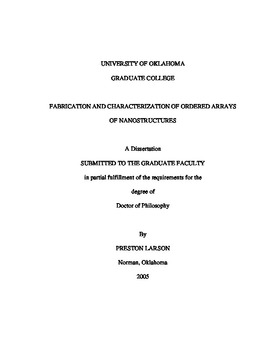| dc.contributor.advisor | Johnson, Matthew B., | en_US |
| dc.contributor.author | Larson, Preston. | en_US |
| dc.date.accessioned | 2013-08-16T12:19:52Z | |
| dc.date.available | 2013-08-16T12:19:52Z | |
| dc.date.issued | 2005 | en_US |
| dc.identifier.uri | https://hdl.handle.net/11244/893 | |
| dc.description.abstract | In this thesis, a combination of bottom-up and top-down approaches is explored to fabricate ordered arrays of nanostrucutures. The bottom-up approach involves the growth of self-organized porous anodic aluminum oxide (AAO) films. AAO films consist of a well ordered hexagonal array of close-packed pores with diameters and spacings ranging from around 5 to 500 nm. Via a top-down approach, these AAO films are then used as masks or templates to fabricate ordered arrays of nanostructures (i.e. dots, holes, meshes, pillars, rings, etc.) of various materials using conventional deposition and/or etching techniques. Using AAO films as masks allows a simple and economical method to fabricate arrays of structures with nano-scale dimensions. Furthermore, they allow the fabrication of large areas (many millimeters on a side) of highly uniform and well-ordered arrays of nanostructures, a crucial requirement for most characterization techniques and applications. Characterization of these nanostructures using various techniques (electron microscopy, atomic force microscopy, UV-Vis absorption spectroscopy, photoluminescence, capacitance-voltage measurements, magnetization hysteresis curves, etc.) will be presented. Finally, these structures provide a unique opportunity to determine the single and collective properties of nanostructure arrays and will have various future applications including but not limited to: data storage, light emitting or sensing devices, nano-tribological coatings for surfaces, bio-sensors, filters, and more. | en_US |
| dc.description.abstract | Nanostructures are currently of great interest because of their unique properties and potential applications in a wide range of areas such as opto-electronic and biomedical devices. Current research in nanotechnology involves fabrication and characterization of these structures, as well as theoretical and experimental studies to explore their unique and novel properties. Not only do nanostructures have the potential to be both evolutionary (state-of-the-art ICs have more and more features on the nanoscale) but revolutionary (quantum computing) as well. | en_US |
| dc.format.extent | xxii, 182 leaves : | en_US |
| dc.subject | Nanostructures. | en_US |
| dc.subject | Nanotechnology. | en_US |
| dc.subject | Physics, Condensed Matter. | en_US |
| dc.title | Fabrication and characterization of ordered arrays of nanostructures. | en_US |
| dc.type | Thesis | en_US |
| dc.thesis.degree | Ph.D. | en_US |
| dc.thesis.degreeDiscipline | Homer L. Dodge Department of Physics and Astronomy | en_US |
| dc.note | Source: Dissertation Abstracts International, Volume: 66-05, Section: B, page: 2643. | en_US |
| dc.note | Adviser: Matthew B. Johnson. | en_US |
| ou.identifier | (UMI)AAI3174404 | en_US |
| ou.group | College of Arts and Sciences::Homer L. Dodge Department of Physics and Astronomy | |
